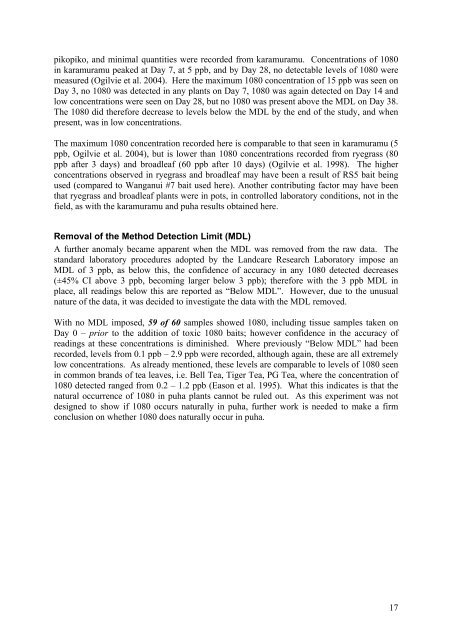Sodium Fluoroacetate (compound 1080) - Lincoln University ...
Sodium Fluoroacetate (compound 1080) - Lincoln University ...
Sodium Fluoroacetate (compound 1080) - Lincoln University ...
Create successful ePaper yourself
Turn your PDF publications into a flip-book with our unique Google optimized e-Paper software.
pikopiko, and minimal quantities were recorded from karamuramu. Concentrations of <strong>1080</strong><br />
in karamuramu peaked at Day 7, at 5 ppb, and by Day 28, no detectable levels of <strong>1080</strong> were<br />
measured (Ogilvie et al. 2004). Here the maximum <strong>1080</strong> concentration of 15 ppb was seen on<br />
Day 3, no <strong>1080</strong> was detected in any plants on Day 7, <strong>1080</strong> was again detected on Day 14 and<br />
low concentrations were seen on Day 28, but no <strong>1080</strong> was present above the MDL on Day 38.<br />
The <strong>1080</strong> did therefore decrease to levels below the MDL by the end of the study, and when<br />
present, was in low concentrations.<br />
The maximum <strong>1080</strong> concentration recorded here is comparable to that seen in karamuramu (5<br />
ppb, Ogilvie et al. 2004), but is lower than <strong>1080</strong> concentrations recorded from ryegrass (80<br />
ppb after 3 days) and broadleaf (60 ppb after 10 days) (Ogilvie et al. 1998). The higher<br />
concentrations observed in ryegrass and broadleaf may have been a result of RS5 bait being<br />
used (compared to Wanganui #7 bait used here). Another contributing factor may have been<br />
that ryegrass and broadleaf plants were in pots, in controlled laboratory conditions, not in the<br />
field, as with the karamuramu and puha results obtained here.<br />
Removal of the Method Detection Limit (MDL)<br />
A further anomaly became apparent when the MDL was removed from the raw data. The<br />
standard laboratory procedures adopted by the Landcare Research Laboratory impose an<br />
MDL of 3 ppb, as below this, the confidence of accuracy in any <strong>1080</strong> detected decreases<br />
(±45% CI above 3 ppb, becoming larger below 3 ppb); therefore with the 3 ppb MDL in<br />
place, all readings below this are reported as “Below MDL”. However, due to the unusual<br />
nature of the data, it was decided to investigate the data with the MDL removed.<br />
With no MDL imposed, 59 of 60 samples showed <strong>1080</strong>, including tissue samples taken on<br />
Day 0 – prior to the addition of toxic <strong>1080</strong> baits; however confidence in the accuracy of<br />
readings at these concentrations is diminished. Where previously “Below MDL” had been<br />
recorded, levels from 0.1 ppb – 2.9 ppb were recorded, although again, these are all extremely<br />
low concentrations. As already mentioned, these levels are comparable to levels of <strong>1080</strong> seen<br />
in common brands of tea leaves, i.e. Bell Tea, Tiger Tea, PG Tea, where the concentration of<br />
<strong>1080</strong> detected ranged from 0.2 – 1.2 ppb (Eason et al. 1995). What this indicates is that the<br />
natural occurrence of <strong>1080</strong> in puha plants cannot be ruled out. As this experiment was not<br />
designed to show if <strong>1080</strong> occurs naturally in puha, further work is needed to make a firm<br />
conclusion on whether <strong>1080</strong> does naturally occur in puha.<br />
17

















